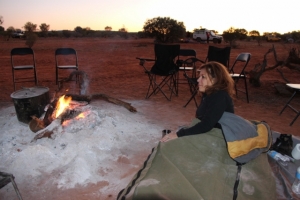Shifting from hurting hearts to rising spirits
Director’s Report – Newsletter December 2019

Hello
I think it is only appropriate to begin this newsletter with acknowledging the tragic death of Kumanjai Walker, which seems to remain in the realm of the most shocking and unspeakable. Our CASSE people send our condolences to all those deeply affected by his death.
From the wailing fires, I draw solace and hope from the work of CASSE with the Warlpiri youth at Willowra and I hope you will do the same; there is a shift from hurting hearts to rising spirits.
These youth have made shields (empowerment and protection) in the name of Kumanjai Walker and placed the death in custody hand on the shield. The camp and forensic meetings gave the Warlpiri youth the opportunity to talk out some feelings of anger and hurt by the campfire at night and in the creekbed by day.
We have been very busy since August and so busy we have not had time to say hello and update you on all our news and trailblazing work!
We have launched our new program, ‘Shields for living Tools for Life‘ which is a rehabilitation program based in the Alice Springs region for ‘at-risk’ youth and/or young people who have come into contact with the youth justice system to reduce the likelihood of offending or reoffending. It is available as part of the Northern Territory Government’s ‘Creating Safer Communities: Back on Track – Cutting Youth Crime’ Initiative.
We have a new Program Co-ordinator, Rainer Chlanda, in Alice Springs – you can read about him and listen to his interview on ABC Radio in this newsletter.
We have a new office in Alice Springs at 79 Bath St.
We have new partners and have been working with the Wirliyajarrayi (Willowra community) since October. We have agreed to deliver four cultural camps on country with the youth, family members and elders, and to hold some forensic meetings with the youth and community meetings.
We have delivered three cultural camps making tools and developing new tools for living and had some forensic meetings. You can read my reflections on my first visit to Willowra in 30+ years here:
I travelled with Rainer in our Tjilirra vehicle on a very hot day. The air conditioning did not work and I bounced around on a hard vinyl seat getting saturated with sweat, with unquenchable thirst despite hydrolyte and got covered and breathed in, the enveloping red dust which found like an octopus, its way onto every surface, crevice and corner. We passed a sign saying Anmatyjerre country and I felt really moved knowing I had traversed this road over 30 years ago with my Anmatjerrre offsider Dick Lechleitner Japanangka whose spirit lives on inside by the campfire. We used to travel to country music and on the backroads, smoking our rollies, rifle out the window, scrutinizing the landscape for turkey or kangaroo, and crossing the cultural divide with lots of stories of jackaroo days and stories of massacre and Stolen Generation. He taught me the ways of the bush and I tried to teach him how to write. For me it was learning ABC all over again!
Now, like then, our MTM truck hurtled over the red road gathering more dust passing mobs of mulga or low saltbush and I was once again, as always, awed by the beauty of the red earth, the majestic silence and the endless space which makes one want to do freewheeling spins, embracing the changing bush vistas.
We stopped at Ti Tree being waved down by the senior traditional owner Mr Teddy Long and his sons. We met for the first time and I showed him photos of me, thirty odd years ago, sitting in the creekbed with a scarf on my head and little (now big) Julie on my lap as I took minutes of a meeting and the cattleyards of Willowra from the Health Business book. I told them I was Naparulla and that I had travelled to Willowra with kwemenje Dick. I told them I knew kwemenje Stumpy Martin and they wanted any photos I might have of him; he was the traditional owner and a man of great standing, always donning his well-worn cowboy hat. Many years before Willowra was and is a cattle-station. They told me all the family lines. I told them when I visited they were all camping in traditional shelters in the creek with only a few houses on the bank. When I got to the community I repeated this story many times. It was sundown and the fiercely hot sun was disappearing behind the sentry gums.
We said hello to many people who all happily introduced themselves and their families. I met my old friend Petronella later and others I had known who were leaving the next morning and we yarned together as they told me stories of the community and about their exciting anthropological and community work mapping sacred sites with the community. At ten that night Rainer and I sat down to eat his delicious pasta sauce exhausted and, I profess, with almost no appetite. We crashed out in our little bedrooms into our swags with, can you believe it, en suite (reddened by dust) in the donga, sharing the spaces with other visitors; and woke to the hot, glinting sun and my dear friend Petronella popping in to say goodbye! As usual we doubled up in laughter in the ten minutes we had together.
Then began, for me, a really amazing day. By late morning we had all the youth in the back of the vehicle (and dare I say it in the front, too) who had been on the first camp ready to embark on our first meeting together. They called me Naparulla and made fun of me suggesting a COOOOOL spot somewhere! They were happy to see Rainer and asked for TjUpurrula – the tool maker and cultural camp co-ordinator. The immediately recognised we were brother and sister and wanted to know who the boss was! It didn’t take long for their shyness to lapse and there was lots of chatter. We stopped at the store and I said they could organise some food for our picnic meeting. They all listed what they wanted and then told me to write it down but I said: “Why don’t you come in and help me get the food?” Nemiah took the lead with a basket in hand and essentially got what had been agreed upon. We put the box of food in the back. They were hungry! The smell of pies was enticing. A few hands darted to the box. I asked them to put the food back and wait till we got to our picnic spot. Back went the food into the box. I couldn’t believe it!
Then I asked them to suggest where we meet. They took us out of Willowra over the first creekbed to the second creekbed where a big shady tree stood. We all piled out. The youth sat themselves in a semi-circle and handed out the food and the food orders in a very team like and orderly manner. Again I could not believe it! I began to talk, shooing flies at the same time. A big black crow landed nearby- He is the devil said Ezekiel. They were full of stories of the first camp.
What was good about it?
Making tools, beating the wood, taking the tools back to community, feeling proud, happy, learning culture, strong, and swimming in the swimming hole.
We talked about the trouble they had been in. How did it make them feel when they were in trouble?
Bad and guilty they chorused for hurting their community.
I drew attention to the difference in feelings.
I told them how they could become a hero and that that’s what they were doing on camp! They were challenged – making meaning and finding purpose in the making of the tools, earning respect from within and the community, and working hard to make good – both object and self. They all want to be a hero!
I told them I had worked in the big maximum security prisons and worked with very “bad” men who had been very violent. I said I learnt two things:
Firstly, no-one, as Tjupurulla says, is born bad or mad and that every man has a story.
Secondly, that this story is always about running scared and having no words for feelings – where “something does your head in”!
I said I didn’t think they were bad but they could do bad things. I told them I stopped an angry man in B Division, HMG Pentridge Prison, dead in his tracks one day when I asked him who had stood over him like he was with me right now and making me feel scared and what had scared him. I said I repeated this question many times with many prisoners and always got the same answer. I asked them if they ever felt scared. They all said: Yes.
What makes you scared?
Drunken people
Gunja people.
Fighting….
What do you do when you are scared?
Run away
Want to hang myself
Get into a temper
Break in to property
Do bad things…
I told them the Cherokee story of the White and Black Wolf. They loved the story. I said we all have inside us a black (I said I didn’t like using the colour code and used the work dark and white – Tjupurrula later said I should reverse the colours!) and White wolf, namely these are our bad and good parts. The son of the old Cherokee asks how the good wolf can win over the bad wolf. The old Cherokee said – You feed only the White wolf.
There was a silence. Nemiah stunned me by saying : But the dark wolf will get angry!
Exactly! I said.
So there is another version of this story.
The old Cherokee said: You have to feed both the dark and white wolf. He said the dark wolf has some good traits like strength and resilience which can be unleashed from the BAD and that the White can grow in caring and compassion and peace…
I then told the story of Chickadee and Plenty Coup (you can read this in our ‘What Why How‘ booklet) which is about valuing education and how the Cherokee turned to wisdom and learning after their buffalo died and their hearts fell to the ground.
A couple of youth who had not been to school that morning rushed back to tell the teacher the story of the two wolves all together saying yes its school its school which is good like Chickadee!
This is just one meeting and just one story, I think, of humanity and hope. Rainer filmed it. You can watch the video of the session here.
So a space and place was created for the youth to talk on their terms and of their choosing. A space was created where feelings could be named, represented and heard. They could tell something of their story, of their motivation to offend and begin to recognise some of their feelings. They highlighted in some ways the absence of containment which leads to enactments of break-ins in the same way the youth may feel broken into or damaged emotionally. Violence and damaging property can be about denied unbearable painful feelings which have not been symbolized, or represented, or talked about, or felt and which can remain as silent screams. Risk taking behavior and thrill seeking can fill in the voids. Some tools however were made and strategies suggested to manage some of their feelings, facilitating hope and some new ways forward in terms of being a hero, the two wolves and chickadee. The telling of stories helps represent feelings and thoughts which have not been represented or held in the past. Next time I plan to talk more about how the youth may recognise their feelings of distress and how they might try not to enact crime in its place and how their risk taking fills the voids of abandonment of caregivers.
I am looking for more stories.
As we head into the festive season I wish you all happy holidays and New Year!
I thank the CASSE team and Board for all their incredible hard work and support and the people of central Australia for opening their hearts and hands in support and holding.
Enjoy and share the stories of our CASSE newsletter and of the Men’s Tjilirra Movement and Shields for Living, Tools for Life; stories of connection, resilience, symbolic of hope and future, grounded in the red earth in the red centre of Australia. There will be more next year!
Pamela Nathan
Director, CASSE Aboriginal Australian Relations Program




